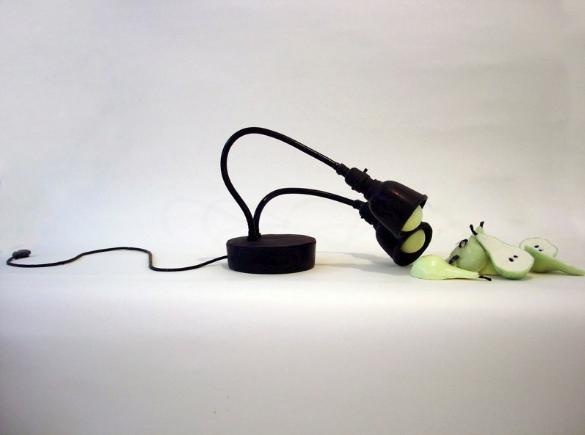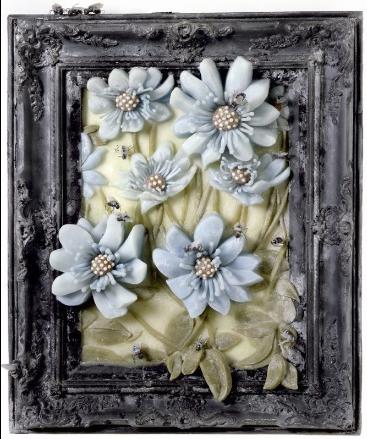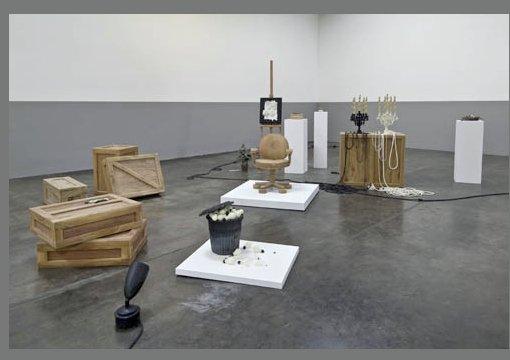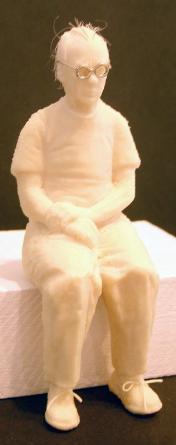could begin by saying that temperamentally I feel a certain resistance to closure and am drawn to diversity, multivalence. Digressions, associative thinking are key. So,
although most of the work is rubber sculpture, cast from hand-modeled clay, there are also videos, photographs, texts, occasional found objects, kinetic pieces--often
combined into an installation, often standing alone as discrete objects. All of these diversities are in aid of a kind of melancholy archaeology. This would include an
archaeology of the studio itself, which I see, metaphorically, as a place of ruin, loss, and deep storage, haunted by vanished voices. Under layers of history a collapsed
site, and among ruins a search for forgotten things. To dig deep into the silted-over layers of the decaying site of production is to search for lost artifacts, lost people, lost
actions, lost art and art forms, hidden infrastructures and architectures. In this excavation one finds even lost studio genres, genres which are aged or extinct, for example,
the genre of the floral painting, of the portrait, or the still life. The archaeological impulse is one of salvage--to unearth what has been buried and at the same time to
contain it, memorialize it. Hence one other part of my work is the making of functional rubber crates in which all the other pieces are literally packed away
Phosphorescent pigment is mixed into most of the rubber works. Maybe this process of excavating the studio involves a post-modern mourning. Certainly, the fact that
among the diminutive portraits the subjects are mainly now dead or otherwise departed suggests that their faint after glow when the lights go out is ghostly. And since the
hair on their rubber heads is sent to labs and used to trace the geographical location of their DNA back as far as 15,000 years ago, they join with with millions of other
ghosts. Maybe mourning makes everything go to seed--weeds and insects invade the studio ruins. Nature itself is frozen or turns toxic. These floral rubber "pictures" and
still lifes also glow in the dark, a slightly sinister effect heightened by the frequent depiction of poisonous or narcotic plants.
Rubber is my addiction, It is evokes flesh--slapping a hunk or rubber is like slapping a side of beef-- and so is connected to mortality. But it is also inherently comedic--it
flops and bounces, unbreakable as humor is irrepressible, spineless and anti-heroic as slapstick..
although most of the work is rubber sculpture, cast from hand-modeled clay, there are also videos, photographs, texts, occasional found objects, kinetic pieces--often
combined into an installation, often standing alone as discrete objects. All of these diversities are in aid of a kind of melancholy archaeology. This would include an
archaeology of the studio itself, which I see, metaphorically, as a place of ruin, loss, and deep storage, haunted by vanished voices. Under layers of history a collapsed
site, and among ruins a search for forgotten things. To dig deep into the silted-over layers of the decaying site of production is to search for lost artifacts, lost people, lost
actions, lost art and art forms, hidden infrastructures and architectures. In this excavation one finds even lost studio genres, genres which are aged or extinct, for example,
the genre of the floral painting, of the portrait, or the still life. The archaeological impulse is one of salvage--to unearth what has been buried and at the same time to
contain it, memorialize it. Hence one other part of my work is the making of functional rubber crates in which all the other pieces are literally packed away
Phosphorescent pigment is mixed into most of the rubber works. Maybe this process of excavating the studio involves a post-modern mourning. Certainly, the fact that
among the diminutive portraits the subjects are mainly now dead or otherwise departed suggests that their faint after glow when the lights go out is ghostly. And since the
hair on their rubber heads is sent to labs and used to trace the geographical location of their DNA back as far as 15,000 years ago, they join with with millions of other
ghosts. Maybe mourning makes everything go to seed--weeds and insects invade the studio ruins. Nature itself is frozen or turns toxic. These floral rubber "pictures" and
still lifes also glow in the dark, a slightly sinister effect heightened by the frequent depiction of poisonous or narcotic plants.
Rubber is my addiction, It is evokes flesh--slapping a hunk or rubber is like slapping a side of beef-- and so is connected to mortality. But it is also inherently comedic--it
flops and bounces, unbreakable as humor is irrepressible, spineless and anti-heroic as slapstick..
| The New York Optimist |
| © MMIX, The New York Optimist. All Rights Reserved. The New York Optimist & www.thenewyorkoptimist.com is a registered trademark of The New York Optimist. The New York Optimist is a registered service mark of Thenewyorkoptimist.com. The New York Optimist logo and original photos are a registered trademark of The New York Optimist . All other photos are property of the advertiser. And are rightfully protected under their copyright protections. |
SHARE
| Jeanne Silverthorne |
| Jeanne (Up and Down) 9” high, 2008, rubber |
| Mutant lamp, pears, and flies. Rubber, 2007 phosphorescent |
| Bad Ideas |
| Phosphorescent Blue with Bees, 2008, rubber |
| Glowing Blue with Bees 24.25x20.5x5” |







| Black and White with Beetles, 2008, rubber |

| DNA Candelabra |

| Task Chair, 2008, rubber, 36” high |

| Rubber Crates, 2008 |


| 'Under a cloud' (detail) |


| “Invisible Worm” 2009 |

| Victoria, phosphorescent rubber, 6 1/2” high, 2005 |

| Bob, phosphorescent rubber, 5” high, 2007 |
